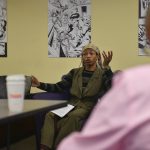
In the wake of the fatal bike crash that killed Boston University research fellow Anita Kurmann, 38, changes to the intersection where the woman was struck are underway to make the area safer for bike riders.
Kurmann was killed Aug. 7 at the intersection of Beacon Street and Massachusetts Avenue — an area notoriously treacherous for cyclists.
Although already a part of the city’s Go Boston 2030 initiative for transportation, the changes to this intersection and others have risen in priority since the Kurmann’s death, wrote Gina Fiandaca, the commissioner of the Boston Transportation Department, in an email.
“Providing safe access on Boston’s local streets for all users is an ongoing effort that we are committed to striving for each day,” Fiandaca said. “In keeping with this goal, in March of this year, the City of Boston joined other major U.S. cities in adopting Vision Zero [Initiative], which is a policy based on the premise that traffic fatalities are not accidents, but rather crashes that can be prevented.”
Changes to the intersection will include flexible posts to mark the bike lane, painted bike boxes at intersections and optimized traffic signals, Fiandaca said. Drivers will not be allowed to make right turns during a red light.
Fiandaca said in addition, trees will be trimmed to improve cyclists’ sight lines, warning signs will be added and the southbound Massachusetts Bay Transportation Authority bus stop for the 1 and CT1 routes will be relocated closer to Marlborough Street.
“Work has begun and, when completed, will provide for a continuous bike lane from the Harvard Bridge through Beacon Street,” she said. “New design features will also enable large vehicles to make turns from the proper lane.”
Vision Zero is part of Go Boston 2030, and includes immediate action steps as well as lengthier projects to improve transportation in the next decade and beyond, Fiandaca said, and the work being done to the intersection of Mass. Ave. and Beacon Street are part of this effort.
Although new design features are intended to protect cyclists and prevent bicycle-related deaths, those in the cycling community say the measures are still not sufficient.
Jessica Mink is the co-founder and former president of the Massachusetts Bicycle Coalition (MassBike), a statewide bike organization that promotes a bicycle-friendly environment. The city is failing to recognize that trucks are a major issue for cyclists, she said.
“The problem is the big trucks,” she said. “[Trucks] have to swing super wide into oncoming traffic. As long as trucks can make that turn, it’s dangerous for bicyclists. Trucks are more dangerous than you think they are, no matter how fast they’re moving. You can get killed. It’s happened often enough to people who didn’t expect it to happen.”
Mink said the amount of traffic moving through the city each day is also another grave danger that cyclists face. She said regulations on who can be where at a given time might help with decreasing the number bicycle-vehicle collisions each year.
“I’ve been riding in Boston traffic for 40 years. [There are] two or three times more cars on the road as there were when I started biking here,” she said. “There aren’t more streets than there were 40 years ago. So it’s going to be an issue — how we share the road.”
Doug Johnson, community organizer of the Boston Cyclists Union, works to repair bikes, educate riders and most importantly, voice support for friendlier street designs.
“We’re really glad that the city is taking steps to make improvements along Mass. Ave. However, the measures they are taking do not go far enough,” Johnson said. “We wish the city had gone further in addressing the intersection and actually took measure to prevent long-term conflict.”
The union took matters into their own hands, and drafted a design proposal, which they sent to the city. The city denied their proposal, and they plan on releasing a public letter informing others of the plan.
“The traffic engineer who is on our board of directors actually came up with a design that would use flex posts, which is what they’re installing along that bike lane, and continue them into the intersection so that when cars make a right turn, it would slow them down and make it a lot safer for cyclists who are going straight through,” he said.
Several residents said they appreciate improvements to increase safety, but feel that more can still be done.
“If anything, [the bike lanes are] a reminder, which I hope will help,” said Linda Whitehead, 61, of Back Bay.
Hayden Swanson, 21, of Allston, said that when he rides his bike, he often sees unsettling sights.
“I always see people driving in the bike lanes, and that is a mistake,” he said. “[Changes] need to happen.”
Collin Norton, 49, of Back Bay said that the renovations don’t solve the main issue between drivers and cyclists but that they at least provide awareness to those who share the road.
“Texting and driving is more dangerous,” he said. “A vehicle is a deadly weapon. The more signage you have, the more awareness you have. Education is key with the public.”
Editor-in-Chief. Bostonian by way of Indiana. Excessive Instagrammer. Seltzer addict. Journalism junkie, storytelling fiend.




